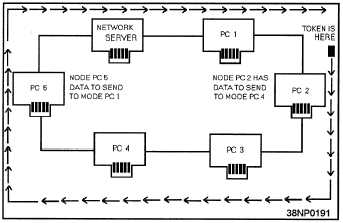communications between element, exchange
information, and terminate communications.
Protocols have two major operational functions. They
establish the circuit for transmission (handshaking)
and for the transmission itself. Transmission is
conducted subject to the line discipline. The line
discipline is the sequence of operations that actually
transmits and receives the data, handles the
error-control procedures, handles the sequencing of
message blocks, and provides for validation for
information received correctly.
Two representative protocols, which control line
d i s c i p l i n e , a r e t h e B i n a r y S y n c h r o n o u s
communications Protocol (Bisync) and the
Synchronous Data Link Control (SDLC).
Bisync
Bisync is a half-duplex protocol that transmits
strings of characters at lower speeds over dial-up
circuits. The information movement is in one
direction at a time, with each data transfer being
answered by an acknowledgement.
SDLC
SDLC is a control procedure that sends multiple
blocks of data and returns a single acknowledgement
for many blocks, thereby increasing the amount of
time spent transmitting data. The bits that are put
before and after the message at the transmitting end
are removed at the receiving end, so only the message
is presented to the user.
Figure 8-7.—A ring network using the token passing
access method.
The hardware chosen for the network plays a part
in the choice of network protocol. Most users and
many of the vendors who build the clone type of
equipment would like to see universal interfaces,
while others think that the availability of different
specifications will lead to a proprietary set of
equipment, even though they favor the overall OSI
specifications.
LAN SYSTEMS
When you decide to install a LAN system, the type
of topology used in the initial wiring of the system
will have a major effect on the type of system that can
be used. There are many LAN systems available,
each with advantages and disadvantages. In the
following paragraphs, we briefly examine some of the
available LAN systems.
The Institute of Electrical and Electronics
Engineers (IEEE) has developed a set of standards for
local-area networks. These standards encourage the
use of common approaches for LAN protocols and
interfaces. The IEEE LAN standards were developed
by a committee of engineers and classified as the 802
standards. The 802 standards are broken down even
further to define the protocols and topology used in a
LAN. Some of the standards we are concerned with
are the following:
I E E E 8 0 2 . 3 — C a r r i e r s e n s e m u l t i p le
access/collision detection (CSMA/CD)
IEEE 802.4—Token Bus
IEEE 802.5—Token ring
ETHERNET
The EtherNet local-area network was developed
by Xerox, the Intel Corporation, and the Digital
Equipment Corporation. It became the model for the
development of the IEEE 802.3 standard. The
original standard defined a maximum throughput for
EtherNet of 10 Mbit/s, but it has been revised to
support throughput of much higher rates. When
operating over coaxial cable, EtherNet has a 20-Mb
per second throughput speed. For high-demand
8-11


